ROG raises the bar for Z390 motherboards
Since its inception way back in 2006, the Republic of Gamers has set the standard for gaming and enthusiast motherboards. We created the category, and with each new generation our designers and engineers refine the formula in pursuit of faster performance, more customization, and a better overall gaming experience.
For Z390, the Maximus XI series embraces the dark side with blacked-out boards in multiple sizes and variations. It leads with the unparalleled Maximus XI Extreme for dream builds, which is followed by armour-clad near twins in Maximus XI Formula and Code. The Maximus XI Apex reprises its role as a premiere overclocking platform for LN2 junkies, the Maximus XI Gene rethinks our approach to microATX, and the Maximus XI Hero strikes the right balance in three different flavors.
Build your dream with the Maximus XI Extreme
Maximus XI Extreme is indulgent without being frivolous. As the flagship, it walks the line between achieving peak performance and providing the extra features that make showcase builds stand out.
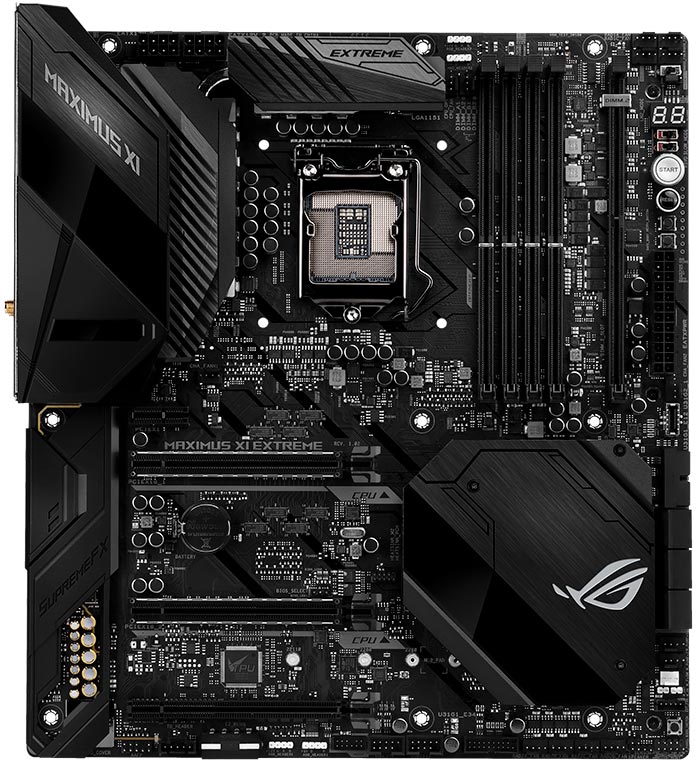
Subtle upgrades for hardcore overclocking are found throughout the board. Dual 8-pin power connectors are capable of delivering more 12V power directly to the CPU, and we’ve adjusted the phase configuration to better distribute the heavier load presented by eight overclocked cores. Serious overclockers can monitor voltages directly with a multimeter using ProbeIt points on the PCB, and there’s a special LN2 mode for sub-zero record attempts.
If you’re building an actual rig, custom liquid loops are basically a requirement at this end of the spectrum, so the Extreme has a special connector just for water blocks. With a single cable, block makers can let the motherboard track flow rates, coolant temperatures, and leak-detection circuits. This augments the separate flow and temperature headers, allowing monitoring at multiple points or for an entirely separate loop.
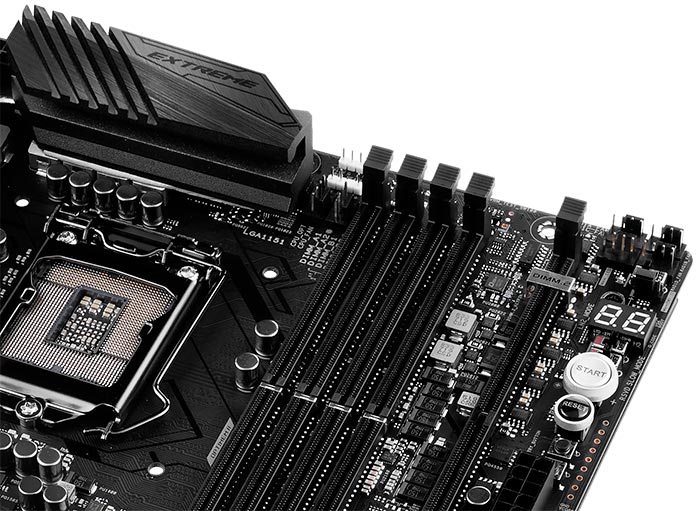
With 16 pump and fan headers, the Extreme is equipped to manage even the most elaborate system cooling with a single powerful interface. There are two onboard pump headers, 12 for fans, and four more via the Fan Extension card included in the box. The headers are also carefully grouped and organized. The liquid zone in the bottom right corner matches typical reservoir locations; two clusters of four fan headers are positioned within reach of beefy radiators at the top, front, and bottom of the chassis; and the rest distributed near typical system fan locations.
While the Extreme arguably looks most striking in stealth mode, where its Vader aesthetic takes center stage, you can still light it up with a fistful of RGB strips. The LiveDash OLED embedded in the I/O cover adds a subtle display for keeping tabs on system vitals or displaying simple text, images, and animations that enable even more customization.
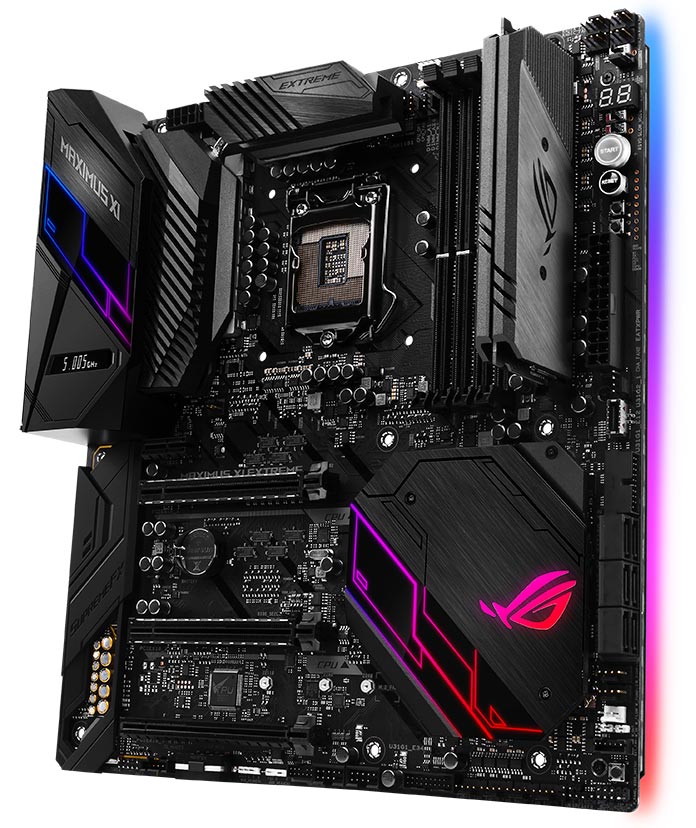
Between the two-slot DIMM.2 module connected directly to the CPU and the pair of M.2 slots hanging off the chipset, the Maximus XI Extreme can cleanly run up to four NVMe SSDs without any wires or drive bays. The spec sheet is stacked with standouts, including wicked-fast 5G wired networking and gigabit-class Intel WiFi. We also added an auxiliary controller to provide even more USB 3.1 Gen 2 ports.
| ROG Maximus XI Extreme | |
|---|---|
| Size | EATX |
| Memory | 4 x DDR4 up to 4400+ (OC) |
| Multi-GPU | 2 x SLI, 3 x CrossFireX |
| PCIe | 2 x16 (CPU): x16, x8/x8 1 x16 (Chipset): x4 1 x1 (Chipset) |
| Storage | 1 x M.2 (NVMe x4 or SATA 6Gbps) 3 x M.2 (NVMe x4) 6 x SATA 6Gbps |
| Networking | Aquantia AQC111C 5G Ethernet Intel I219-V Gigabit Ethernet 2x2 802.11ac WiFi MU-MIMO |
| Audio | SupremeFX S1220 codec |
| USB | 3.1 Gen 2: 1 x front, 1 x Type-C, 3 x Type-A 3.1 Gen 1: 4 x front, 6 x Type-A 2.0: 4 x front |
| Aura | IO shield, chipset heatsink, right edge, 2 x strip headers, 2 x addressable headers |
| Cooling | 2 x pump+ headers 12 x fan headers 3 x thermal sensor headers (2 x liquid) 1 x flow header 1 x block header |
| Price | $599.99 USD $779.99 CAD |
| Availability (USA) | US Vendors |
| Availability (Canada) | Canada Vendors |
One Maximus to rule the rest, the new Extreme raises the stakes for premium Z390 motherboards. Priced at $599.99 USD and $779.99 CAD, the Maximus XI Extreme are available now.
Choose between the liquid-ready Maximus XI Formula and streamlined Maximus XI Code
Fraternal twins based on the same foundation, the Maximus XI Formula and Maximus XI Code have distinctly different missions. The Formula is plumbed for custom liquid cooling and includes other enhancements to punctuate premium systems, while the Code takes a more straightforward approach that extends from the spec to the armored exterior.

We collaborated with the experts at EK Water Blocks to create the CrossChill EK III VRM block for the new Formula. Designed for the higher VRM load associated with eight-core CPUs, the block has a wider internal channel and more copper to improve thermal dissipation. It’s compatible with standard fittings to simplify integration with the rest of your loop and nicely complements the coolant flow and temperature sensors available on the board.
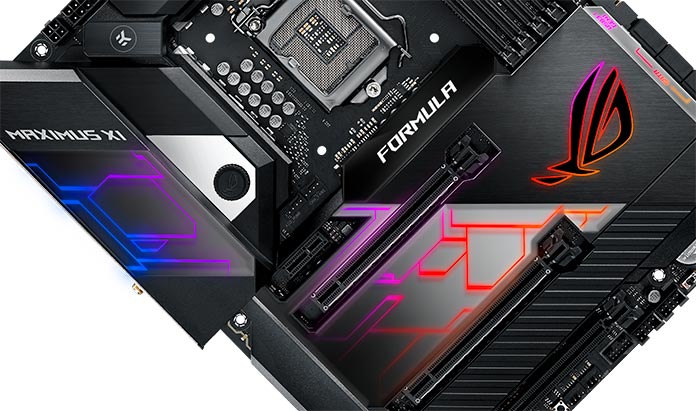
The Formula advances customizable aesthetics with intricate patterns cut into its reflective armor, plus illuminated labels for SATA and front-panel USB ports. A larger LiveDash OLED sits in prime view below the socket and boasts a 256×64 resolution that offers more room for monitoring system stats and showing your own graphics and messages. It’s part of a broader effort to bring useful displays to more of our devices, including the ROG Thor PSU and Ryuo and Ryujin liquid coolers.
Wired networking gets a substantial boost from the Formula’s Aquantia 5G Ethernet controller, which is the same chip used on the Extreme. This is the only key spec where Code differs. Both boards are based on the same PCB and otherwise share identical layouts and connectivity. They’re fully loaded with onboard WiFi, dual M.2 slots covered by heatsinks, and loads of USB ports poking through integrated I/O shields.

Despite lacking the CrossChill EK III VRM block, the Code still has temperature and flow headers for liquid loops along with separate connectors for an all-in-one cooler and dedicated pump. With six additional fan headers, including one capable of pushing high-amperage spinners, both have ample capacity for complete system cooling.
| ROG Maximus XI Formula | ROG Maximus XI Code | |
|---|---|---|
| Size | ATX | |
| Memory | 4 x DDR4 up to 4400+ (OC) | |
| Multi-GPU | 2 x SLI, 3 x CrossFireX | |
| PCIe | 2 x16 (CPU): x16, x8/x8 1 x16 (Chipset): x4 1 x1 (Chipset) |
|
| Storage | 1 x M.2 (NVMe x4 or SATA 6Gbps) 1 x M.2 (NVMe x4) 6 x SATA 6Gbps |
|
| Networking | Aquantia AQC111C 5G Ethernet Intel I219-V Gigabit Ethernet 2x2 802.11ac WiFi MU-MIMO | Intel I219-V Gigabit Ethernet 2x2 802.11ac WiFi MU-MIMO |
| Audio | SupremeFX S1220 codec | |
| USB | 3.1 Gen 2: 1 x front, 1 x Type-C, 3 x Type-A 3.1 Gen 1: 4 x front, 6 x Type-A 2.0: 4 x front |
|
| Aura | IO shield, armor, power/reset buttons, 2 x strip headers, 2 x addressable headers | |
| Cooling | 2 x pump headers (AIO, pump+) 5 x fan headers 1 x high-amperage fan header 3 x thermal sensor headers (2 x liquid) 1 x flow header |
|
| Price | $449.99 USD $584.99 CAD | $349.99 USD $454.99 CAD |
| Availability (USA) | US Vendors | US Vendors |
| Availability (Canada) | Canada Vendors | Canada Vendors |
Subtler armour blankets the Code’s exterior to protect the PCB and give builds a cleaner overall look. The board is better for streamlined systems that eschew the extravagances found in typical Formula builds, and the price tag is lower as a result. The Maximus XI Code is available now at the retailers above for $349.99 USD and $454.99 CAD, while the Maximus XI Formula pushes the price to $449.99 USD and $584.99 CAD.
Break overclocking records with the Maximus XI Apex
All of ROG’s Z390 motherboards are made for overclocking, but none quite like the Maximus XI Apex. This board isn’t just for taking clocks beyond stock speeds; it’s purpose-built to push them higher than ever before. Since it was first introduced two generations ago, the Apex series has claimed frequency and benchmark records on Z270, X299, and Z370 platforms. Now, it’s poised to take on Intel’s first eight-core desktop CPU.
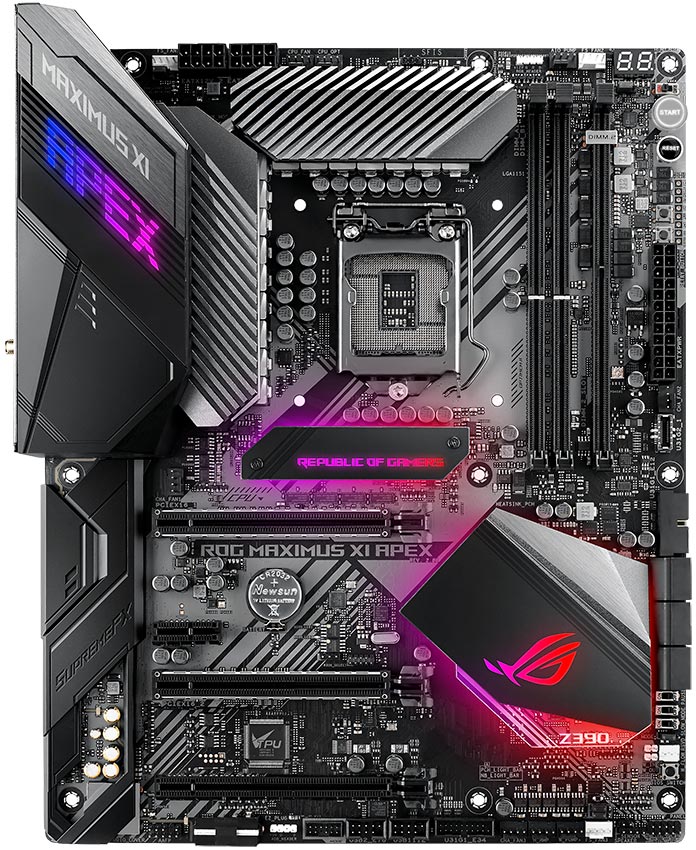
Good CPUs can reach extraordinary frequencies when chilled to sub-zero temperatures, but they demand a lot of stable power. The Apex delivers with an upgraded VRM fed by dual eight-pin auxiliary power connectors. There are more phases than on even the Extreme, which is a testament to what it takes to eke out the last few MHz at the limits of the silicon.
Running at sub-zero temperatures is required to reach the top of the leaderboards, so the Apex has special operating modes for LN2 junkies. Elite overclockers are known for meticulously insulating their boards to deal with the resulting condensation. That part is still up to you, but we add a condensation detection circuit that can provide a warning if your defenses are breached. ProbeIt points are also available for closely monitoring vital voltages with a multimeter.
With 10 fan headers, the onboard cooling has enough capacity for more specialization. Three headers are locked at full speed and meant for blowing away the vapor that billows from LN2 pots. Two are configured for liquid cooling at conventional temperatures, and they’re joined by headers for monitoring the flow and temperature in custom loops.
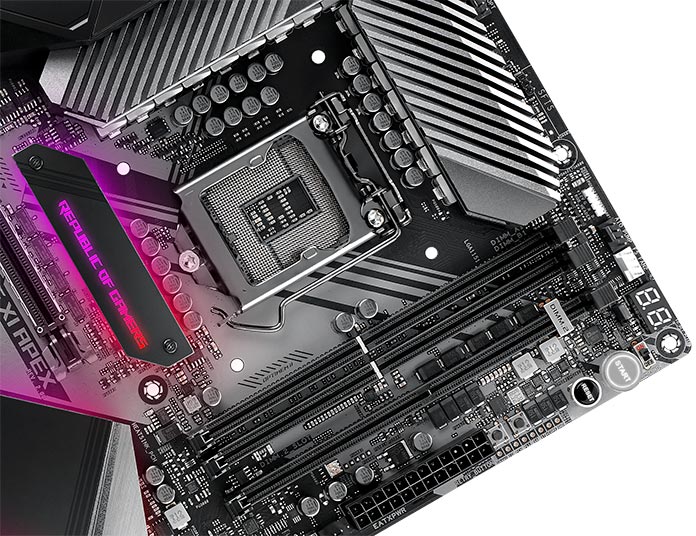
Having one DIMM per memory channel makes the traces to the CPU more direct, which enables higher frequencies. With the right modules, you can overclock up to DDR4-4600 and beyond. This configuration limits total memory capacity to 32GB with standard modules, so we developed Double Capacity DRAM that essentially puts two DIMMs on a single, taller stick. G.Skill and Zadak are prepping compatible kits that will allow you to install 64GB of RAM on the Apex and other dual-slot boards in the Maximus XI series.
Doubling up is a consistent theme. Next to the memory sits a DIMM.2 module with two M.2 slots sandwiched by a passive heatsink. There are also dual PCIe x16 slots to the south for two-way SLI and CrossFireX. Support for four graphics cards is required to be competitive in some benchmarks, but the Rampage VI Apex is better-equipped for that mission thanks to the greater PCIe bandwidth available through its X299 platform and Skylake-X CPU.
| ROG Maximus XI Apex | |
|---|---|
| Size | ATX |
| Memory | 2 x DDR4 up to 4600+ (OC) |
| Multi-GPU | 2 x SLI, 3 x CrossFireX |
| PCIe | 2 x16 (CPU): x16, x8/x8 1 x16 (Chipset): x4 1 x1 (Chipset) |
| Storage | 2 x M.2 (NVMe x4) 6 x SATA 6Gbps |
| Networking | Intel I219-V Gigabit Ethernet 2x2 802.11ac WiFi MU-MIMO |
| Audio | SupremeFX S1220 codec |
| USB | 3.1 Gen 2: 1 x front, 1 x Type-C, 3 x Type-A 3.1 Gen 1: 2 x front, 6 x Type-A 2.0: 4 x front |
| Aura | IO shield, center badge, chipset heatsink, 1 x strip header, 1 x addressable header |
| Cooling | 2 x pump headers 5 x fan headers 3 x full-speed fan headers 1 x high-amperage fan header 3 x thermal sensor headers (2 x liquid) 1 x flow header |
| Price | NA |
| Availability (USA) | NA |
| Availability (Canada) | NA |
Although it’s very much built for life on the edge, the Maximus XI Apex still has creature comforts for everyday builds, such as extensive connectivity, fast WiFi, and tasteful onboard lighting. It will be available later this year; look for it on the HWBot leaderboards.
The Maximus XI Gene offers a new approach to microATX
The Gene is back with the Maximus XI family, this time with a twist. Multi-GPU configurations are becoming rarer as NVIDIA and AMD focus on single-card performance, and GPU coolers are growing beyond two slots to improve performance and reduce noise. The old Gene’s dual-GPU focus doesn’t reflect the kinds of systems gamers and enthusiasts are building, so the new model refocuses to aggressively pursue higher performance and support additional storage.
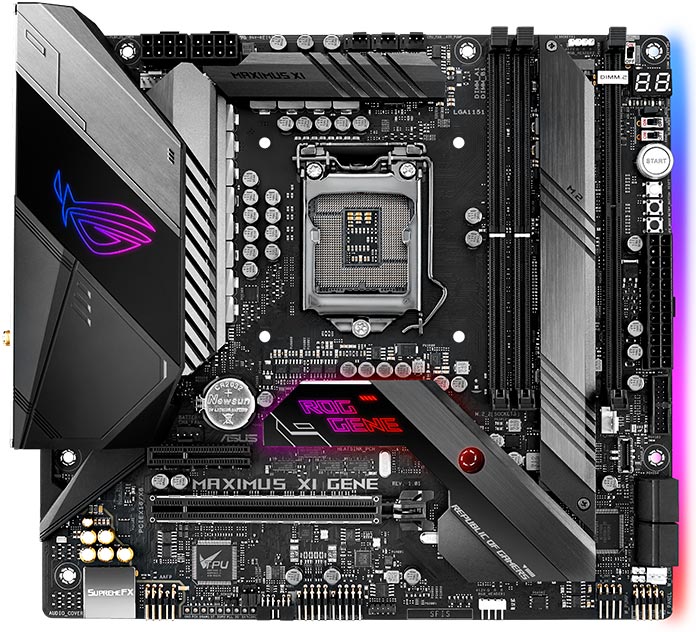
With the same dual 12V CPU power connectors and rebalanced VRM as the Extreme, the Maximus XI Gene effortlessly powers eight-core processors pushed to the very limit. Its substantial VRM heatsinks help to compensate for the reduced airflow typically found in more compact systems. The Gene includes an LN2 mode for record-setting benchmark runs and ProbeIt points to closely monitor voltages when you’re on the edge. You also get dual high-speed fan headers for blowing smoke and enough standard cooling connectors for a collection of fans and liquid components.
We switched to dual DIMM slots to enable higher memory frequencies, allowing the board to support modules running at up to DDR4-4533 and higher. Double Capacity DRAM support ensures you can still run 64GB, providing the versatility to seek maximum speed or capacity. Look for new G.Skill TridentZ RGB DC and Zadak Shield DC Aura2 kits to double up on DRAM.
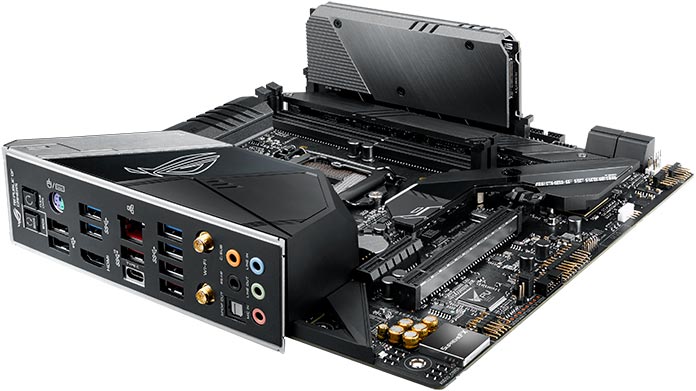
Removing two DIMM slots leaves room for a DIMM.2 module with integrated heatsinks for two NVMe SSDs connected to the CPU. There are slots for two more M.2 drives under a heatsink between the memory and DIMM.2 slots, putting all your high-speed storage and memory in the same region for easy cooling. You can load up on SSDs without cluttering your build and combine all four in a bootable NVMe RAID array with phenomenal speed and capacity.
| ROG Maximus XI Gene | |
|---|---|
| Size | microATX |
| Memory | 2 x DDR4 up to 4600+ (OC) |
| Multi-GPU | NA |
| PCIe | 1 x16 (CPU) 1 x1 (Chipset) |
| Storage | 4 x M.2 (NVMe x4) 4 x SATA 6Gbps |
| Networking | Intel I219-V Gigabit Ethernet 2x2 802.11ac WiFi MU-MIMO |
| Audio | SupremeFX S1220 codec |
| USB | 3.1 Gen 2: 1 x front, 1 x Type-C, 3 x Type-A 3.1 Gen 1: 2 x front, 6 x Type-A 2.0: 4 x front |
| Aura | IO shield, chipset heatsink, 2 x strip headers |
| Cooling | 2 x pump headers (AIO, pump+) 3 x fan headers 2 x full-speed fan headers 3 x thermal sensor headers (2 x liquid) 1 x flow header |
| Price | NA |
| Availability (USA) | NA |
| Availability (Canada) | NA |
Although it has a similar footprint to conventional microATX boards, the Maximus XI Gene is anything but. From little hints like the edge-facing connectors at the bottom, to more obvious features like the substantial VRM and M.2 heatsinks, the board charts a new course for microATX. Check with your local ASUS ROG representative for details about availability in your region.
Choose your own Maximus XI Hero
As the gatekeeper for the family, the Maximus XI Hero has to strike a more delicate balance than the rest of the series. We constantly reevaluate the spec to ensure that the board delivers the right mix of our latest features in a complete package that’s unmistakably ROG.
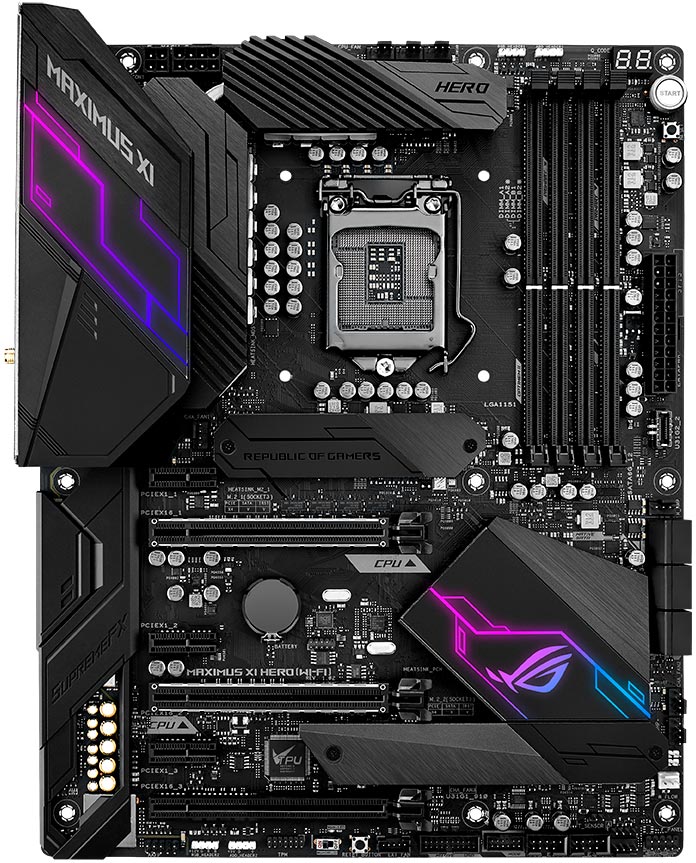
Back in black for a new generation, the Maximus XI Hero embodies ROG’s murdered-out motif down to the little details on the PCB, like neutral slots, headers, and switches. The monochromatic shades and angular lines arguably look best in stealth mode, with every onboard LED dark, but you can still light up patterns on the I/O cover and PCH in addition to driving multiple standard and addressable RGB strips.
Silk-screened labels on the PCB clearly identify key features for inexperienced builders, like the CPU-connected PCIe slots for graphics cards, and the primary DRAM slots that need to be populated for a dual-channel memory config—you wouldn’t want to miss those! These helpful highlights can be found on other Maximus models, as well.
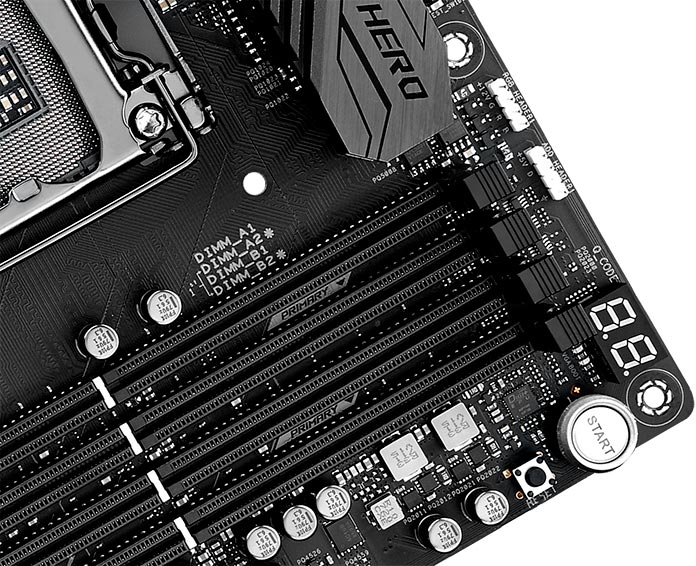
To provide additional headroom for overclocked CPUs, the Hero adds a second 12V power connector and substantial VRM heatsinks. There’s plenty of cooling connectivity onboard, including headers for multiple pumps, up to six fans, and sensors that monitor coolant flow and temperatures. SSD cooling is covered by an M.2 heatsink affixed to each of the two onboard slots.
The integrated I/O shield has quickly become a staple of ROG motherboards, and it’s packed on the Hero. You get loads of USB ports for all your gear, including multiple VR trackers and game controllers. One port works with USB BIOS Flashback, another ROG staple that can update the UEFI using just a thumb drive and power supply, with no CPU or other components required. Intel Gigabit Ethernet is standard equipment, with comparable WiFi available on a second version of the board with integrated wireless.
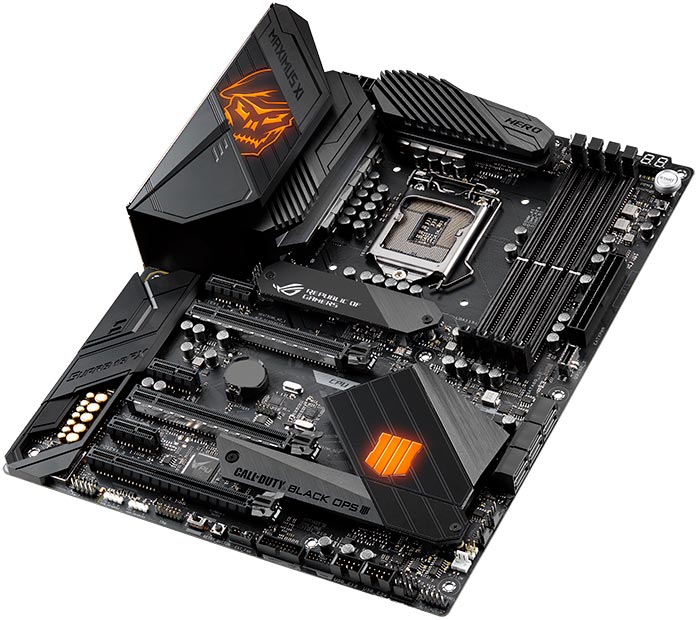
A third version of the Hero celebrates ROG’s collaboration with Call of Duty. Instead of the usual onboard lighting, the Maximus XI Hero (Wi-Fi) Call of Duty: Black Ops 4 Edition illuminates the FPS franchise’s recognizable skull and BO4 icon, plus a different look for the PCH and M.2 heatsinks. The board shares styling with the other hardware in our Black Ops 4 collection, so you can put together a matching rig that combines ROG and COD.
| ROG Maximus XI Hero (Wi-Fi) | |
|---|---|
| Size | ATX |
| Memory | 4 x DDR4 up to 4400+ (OC) |
| Multi-GPU | 2 x SLI, 3 x CrossFireX |
| PCIe | 2 x16 (CPU): x16, x8/x8 1 x16 (Chipset): x4 3 x1 (Chipset) |
| Storage | 1 x M.2 (NVMe x4 or SATA 6Gbps) 1 x M.2 (NVMe x4) 6 x SATA 6Gbps |
| Networking | Intel I219-V Gigabit Ethernet 2x2 802.11ac WiFi MU-MIMO (optional) |
| Audio | SupremeFX S1220 codec |
| USB | 3.1 Gen 2: 1 x front, 1 x Type-C, 3 x Type-A 3.1 Gen 1: 2 x front, 2 x Type-A 2.0: 4 x front, 2 x Type-A |
| Aura | IO shield, chipset heatsink, 2 x strip headers, 2 x addressable headers |
| Cooling | 2 x pump headers (AIO, pump+) 5 x fan headers 1 x high-amperage fan header 3 x thermal sensor headers (2 x liquid) 1 x flow header |
| Price | $289.99 USD $376.99 CAD |
| Availability (USA) | US Vendors |
| Availability (Canada) | Canada Vendors |
The ROG Maximus XI Hero (Wi-Fi) rings in at an attainable $289.99 USD and $376.99 CAD, and pricing for the exclusive Black Ops 4 Edition will be announced soon. Check pricing and availability in the links above to buys yours today, and ask your local ASUS ROG rep if you’re interested in the wireless Hero.

